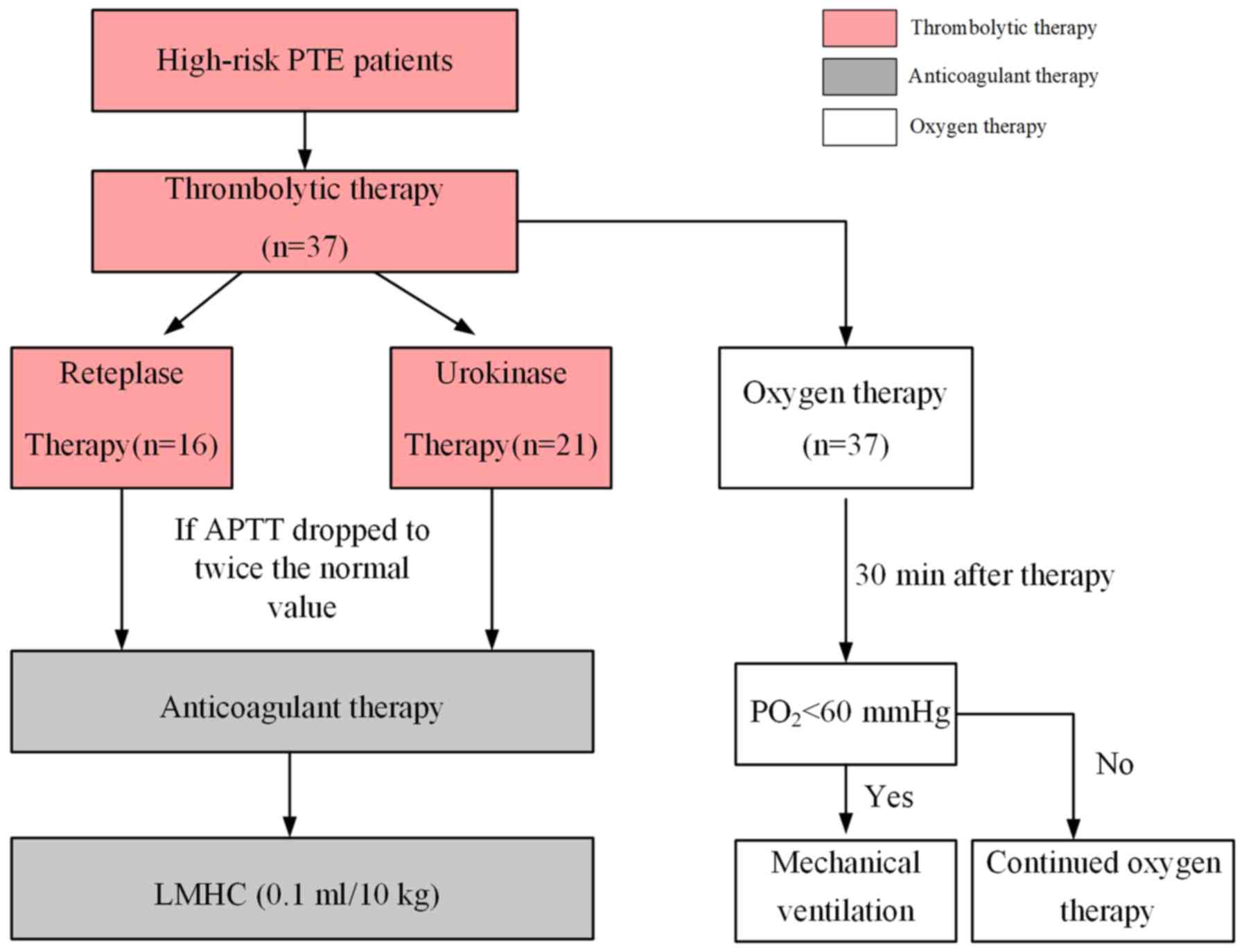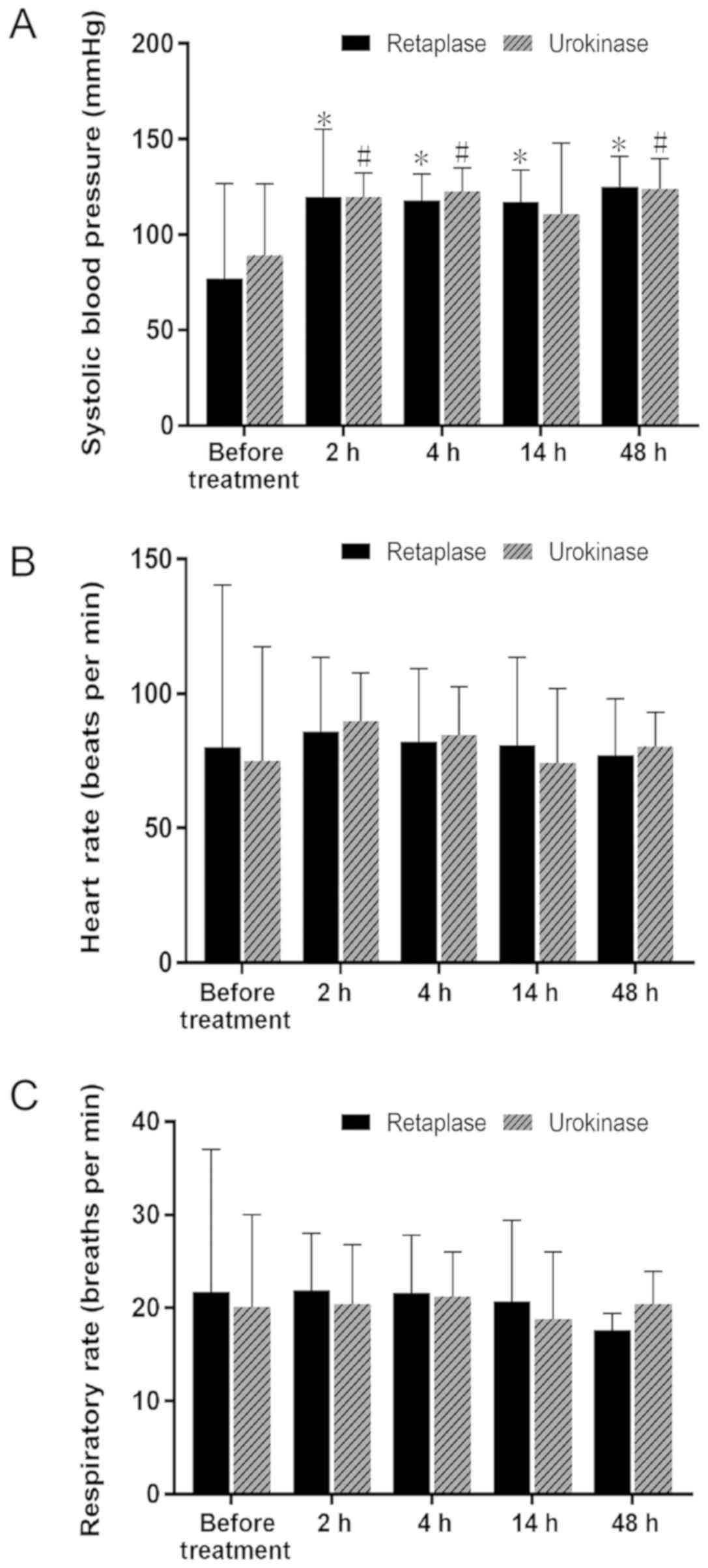|
1
|
Meyer G: Effective diagnosis and treatment
of pulmonary embolism: Improving patient outcomes. Arch Cardiovasc
Dis. 107:406–414. 2014. View Article : Google Scholar : PubMed/NCBI
|
|
2
|
Chalikias G and Konstantinides S: Acute
phase treatment of pulmonary embolism. Curr Vasc Pharmacol.
12:393–400. 2014. View Article : Google Scholar : PubMed/NCBI
|
|
3
|
Streiff MB, Agnelli G, Connors JM,
Crowther M, Eichinger S, Lopes R, McBane RD, Moll S and Ansell J:
Guidance for the treatment of deep vein thrombosis and pulmonary
embolism. J Thromb Thrombolysis. 41:32–67. 2016. View Article : Google Scholar : PubMed/NCBI
|
|
4
|
Marti C, John G, Konstantinides S,
Combescure C, Sanchez O, Lankeit M, Meyer G and Perrier A: Systemic
thrombolytic therapy for acute pulmonary embolism: A systematic
review and meta-analysis. Eur Heart J. 36:605–614. 2015. View Article : Google Scholar : PubMed/NCBI
|
|
5
|
Stone J, Hangge P, Albadawi H, Wallace A,
Shamoun F, Knuttien MG, Naidu S and Oklu R: Deep vein thrombosis:
Pathogenesis, diagnosis, and medical management. Cardiovasc Diagn
Ther. 7 (Suppl 3):S276–S284. 2017. View Article : Google Scholar : PubMed/NCBI
|
|
6
|
Marcos-Contreras OA, Ganguly K, Yamamoto
A, Shlansky-Goldberg R, Cines DB, Muzykantov VR and Murciano JC:
Clot penetration and retention by plasminogen activators promote
fibrinolysis. Biochem Pharmacol. 85:216–222. 2013. View Article : Google Scholar : PubMed/NCBI
|
|
7
|
Sadowski M, Ząbczyk M and Undas A:
Coronary thrombus composition: Links with inflammation, platelet
and endothelial markers. Atherosclerosis. 237:555–561. 2014.
View Article : Google Scholar : PubMed/NCBI
|
|
8
|
Smalling RW, Bode C, Kalbfleisch J, Sen S,
Limbourg P, Forycki F, Habib G, Feldman R, Hohnloser S and Seals A:
More rapid, complete, and stable coronary thrombolysis with bolus
administration of reteplase compared with alteplase infusion in
acute myocardial infarction. RAPID Investigators. Circulation.
91:2725–2732. 1995. View Article : Google Scholar : PubMed/NCBI
|
|
9
|
Rosenberg DG, Levin E, Lausell A, Brown A,
Gardner J, Perez E, Veenendaal M, Ong YS and Gunn M: Feasibility
and timing of prehospital administration of reteplase in patients
with acute myocardial infarction. J Thromb Thrombolysis.
13:147–153. 2002. View Article : Google Scholar : PubMed/NCBI
|
|
10
|
Morrow DA, Antman EM, Sayah A, Schuhwerk
KC, Giugliano RP, deLemos JA, Waller M, Cohen SA, Rosenberg DG,
Cutler SS, et al: Evaluation of the time saved by prehospital
initiation of reteplase for ST-elevation myocardial infarction:
Results of the early retavase-thrombolysis in myocardial infarction
(ER-TIMI) 19 trial. J Am Coll Cardiol. 40:71–77. 2002. View Article : Google Scholar : PubMed/NCBI
|
|
11
|
Luiz T, Wilhelms A, Madler C, Pollach G,
Haaff B, Grüttner J and Viergutz T: Outcome of out-of-hospital
cardiac arrest after fibrinolysis with reteplase in comparison to
the return of spontaneous circulation after cardiac arrest score in
a geographic region without emergency coronary intervention. Exp
Ther Med. 13:1598–1603. 2017. View Article : Google Scholar : PubMed/NCBI
|
|
12
|
Adivitiy a and Khasa YP: The evolution of
recombinant thrombolytics: Current status and future directions.
Bioengineered. 8:331–358. 2017. View Article : Google Scholar : PubMed/NCBI
|
|
13
|
Lippi G, Mattiuzzi C and Favaloro EJ:
Novel and emerging therapies: Thrombus-targeted fibrinolysis. Semin
Thromb Hemost. 39:48–58. 2013.PubMed/NCBI
|
|
14
|
Jaff MR, McMurtry MS, Archer SL, Cushman
M, Goldenberg N, Goldhaber SZ, Jenkins JS, Kline JA, Michaels AD,
Thistlethwaite P, et al: Management of massive and submassive
pulmonary embolism, iliofemoral deep vein thrombosis, and chronic
thromboembolic pulmonary hypertension: A scientific statement from
the American Heart Association. Circulation. 123:1788–1830. 2011.
View Article : Google Scholar : PubMed/NCBI
|
|
15
|
Pulmonary Circulation and Right
Ventricular Function Assembly of Chinese Society of Cardiology of
Chinese Medical Association: Chinese expert consensus on the
diagnosis and management of acute pulmonary embolism (2015).
Zhonghua Xin Xue Guan Bing Za Zhi. 44:197–211. 2016.(In Chinese).
PubMed/NCBI
|
|
16
|
Simpson D, Siddiqui MA, Scott LJ and
Hilleman DE: Reteplase: A review of its use in the management of
thrombotic occlusive disorders. Am J Cardiovasc Drugs. 6:265–285.
2006. View Article : Google Scholar : PubMed/NCBI
|
|
17
|
Department of Pulmonary Vascular Diseases,
Chinese Medical Association Cardiovascular Disease: Chinese expert
consensus on the diagnosis and management of acute pulmonary
embolism. Chin J Intern Med. 49:74–81. 2010.(In Chinese).
|
|
18
|
Konstantinides SV, Torbicki A, Agnelli G,
Danchin N, Fitzmaurice D, Galiè N, Gibbs J, Huisman MV, Humbert M,
Kucher N, et al: Authors/task force members. corrigendum to: 2014
ESC Guidelines on the diagnosis and management of acute pulmonary
embolism. Eur Heart J. 36:26422015. View Article : Google Scholar : PubMed/NCBI
|
|
19
|
Torbicki A, Perrier A, Konstantinides S,
Agnelli G, Galiè N, Pruszczyk P, Bengel F, Brady AJ, Ferreira D,
Janssens U, et al: ESC committee for practice guidelines (CPG).
Guidelines on the diagnosis and management of acute pulmonary
embolism: The task force for the diagnosis and management of acute
pulmonary embolism of the European society of cardiology (ESC). Eur
Heart J. 29:2276–2315. 2008.PubMed/NCBI
|
|
20
|
Bloomer TL, El-Hayek GE, McDaniel MC,
Sandvall BC, Liberman HA, Devireddy CM, Kumar G, Fong PP and Jaber
WA: Safety of catheter-directed thrombolysis for massive and
submassive pulmonary embolism: Results of a multicenter registry
and meta-analysis. Catheter Cardiovasc Interv. 89:754–760. 2017.
View Article : Google Scholar : PubMed/NCBI
|
|
21
|
Daley MJ, Murthy MS and Peterson EJ:
Bleeding risk with systemic thrombolytic therapy for pulmonary
embolism: Scope of the problem. Ther Adv Drug Saf. 6:57–66. 2015.
View Article : Google Scholar : PubMed/NCBI
|
|
22
|
Long B and Koyfman A: Current
controversies in thrombolytic use in acute pulmonary embolism. J
Emerg Med. 51:37–44. 2016. View Article : Google Scholar : PubMed/NCBI
|
|
23
|
Nagamalesh UM, Prakash VS, Naidu KCK,
Sarthak S, Hegde AV and Abhinay T: Acute pulmonary thromboembolism:
Epidemiology, predictors, and long-term outcome-A single center
experience. Indian Heart J. 69:160–164. 2017. View Article : Google Scholar : PubMed/NCBI
|
|
24
|
Goldhaber SZ, Kessler CM, Heit J, Markis
J, Sharma GV, Dawley D, Nagel JS, Meyerovitz M, Kim D and Vaughan
DE: Randomised controlled trial of recombinant tissue plasminogen
activator versus urokinase in the treatment of acute pulmonary
embolism. Lancet. 2:293–298. 1988. View Article : Google Scholar : PubMed/NCBI
|
|
25
|
Mannu GS: The non-cardiac use and
significance of cardiac troponins. Scott Med J. 59:172–178. 2014.
View Article : Google Scholar : PubMed/NCBI
|
|
26
|
Olson JD: D-dimer: An overview of
hemostasis and fibrinolysis, assays, and clinical applications. Adv
Clin Chem. 69:1–46. 2015. View Article : Google Scholar : PubMed/NCBI
|
|
27
|
Liu XY, Zhang Y, Li MW, Wang XP, Qi DD,
Hao PY, Zhang H, Cheng QQ, Zhao LS, Gao CY and Hu DY: Efficacy of
thrombolytic therapy using reteplase in cases with acute ST-segment
elevation myocardial infarction: Results from a multicenter
clinical trial. Zhonghua Xin Xue Guan Bing Za Zhi. 44:766–770.
2016.(In Chinese). PubMed/NCBI
|
















